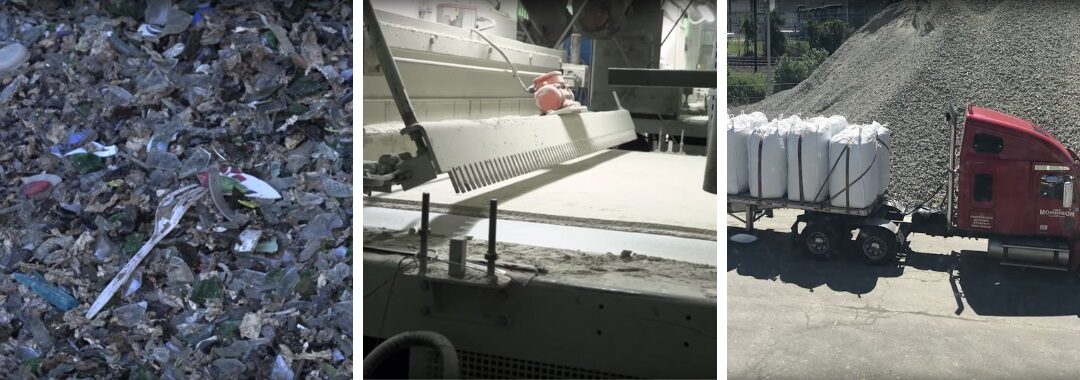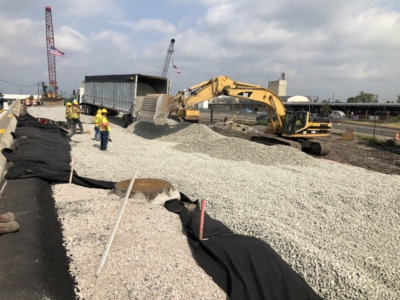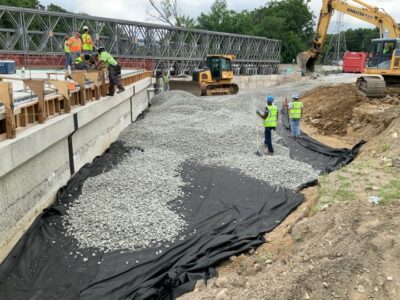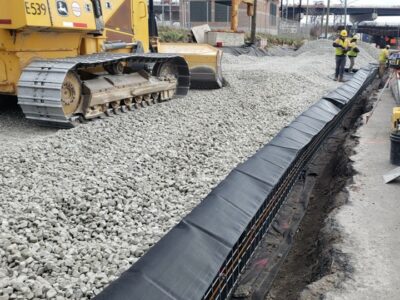NJDOT, like other State departments of transportation (DOTs), has become increasingly conscious of infrastructure’s environmental burdens and are seeking more environmentally sustainable materials in construction. Recently, we spoke with Kimberly Sharp, Manager, Structural Design, Geotechnical Engineering and Geology, and Mohab Hussein, Project Engineer, Deputy Chief Technical, Geotechnical Engineering about NJDOT’s adoption of Foamed Glass Aggregate which serves an example of the deployment of an innovative, sustainable material.
To make foamed glass aggregate, crushed container glass is collected from recycling companies, finely ground into powder and mixed with a foaming agent, and sent through a kiln and softened. Bubbles form within the softened glass. When it cools, the material cracks and forms lightweight, coarse, foam-like aggregate pieces that can be used in various transportation construction projects.
Q. How did you learn of this material?
Aero Aggregates in Eddystone, Pennsylvania, reached out to the Department in 2018 to provide a technical presentation on foamed glass aggregate. An industry presentation is an established step in NJDOT’s process for exploring new technologies. If we are interested in the product, as we were in foamed glass aggregate, we start a pilot project.
Q. When did NJDOT begin using foam glass aggregate?
Our pilot project was the Rt. 7 Wittpenn Bridge in Kearny, NJ in 2019. Use of this material replaced 32,000 cu.yds. of regular fill and saved almost 28 million bottles from the landfill. We used the material for a crossover from one side of the road to the other. We built it and let the contractor use the area for six weeks with heavy equipment traveling over it. We maintained survey equipment at the site and looked for settlement and any lateral spreading and nothing moved.
Q. What have been the most common uses?
For us at NJDOT, the most common uses have been as fill underneath roadways to raise the profile, behind existing abutments where we were putting in a new backwall and new girders and we wanted to lighten the lateral forces on the backwall, as backfill to the approach to a bridge, to resolve sheeting issues on a project, and as backfill behind a temporary wire wall.
We have very soft, compressible soils beneath some of our roadways, and in areas of high tide or frequent flooding, therefore we want to raise the elevation of the roadway. Using heavy, natural fill material beneath the pavement box can lead to pavement that ultimately would ride like a roller coaster due to uneven settling. A less costly approach is to over-excavate the existing soil and place with the foamed glass aggregate. At 22 lbs./cu.ft., the aggregate is buoyant, so regular weight soil is placed over it to weigh it down, and then the pavement box is built on top of the soil. Use of the aggregate lessens the amount of settlement and results in a nice smooth roadway.
Q. Who are suppliers of this material?
Aero Aggregates is the supplier that we work with. They recycle glass from Pennsylvania and from a southern New Jersey recycling center. We appreciate that they are using local materials.
Q. What are the environmental benefits of using this material? What is it replacing?
Foamed glass aggregate is saving millions of bottles from landfills. This material is made of 100 percent recycled material. In addition, the material replaces traditional backfill that would be quarried, and so minimizes depletion of natural resources. It also minimizes use of other material such as rebar, concrete and other foundation elements. In addition, it is lightweight, about half the weight of regular lightweight fill material, and so reduces transportation emissions. There are associated cost savings to its use.
Q. Is there an ongoing assessment process for use of this material, or is it an established process?
We had questions in the beginning. The material was so light that we worried about its durability. The manufacturer provided results from testing and we tested the material in the field. Use of foamed glass aggregate is an established process at NJDOT. The material was first used in Germany in the 1980s, and in Norway in the 1990s to prevent rutting of pavements because it has good insulating qualities. It is useful in cold regions.
Q. Are there limits to the transportation construction applications where this material can be used?
Foamed glass aggregate has its own compaction requirements; it is lightly compacted or graded out with lightweight equipment to avoid crushing of the aggregate. As mentioned above, it requires capping to weigh it down. Pavement design engineers want several inches of regular weight soil between the lightweight aggregate and the pavement box.
Q. What is the state of industry knowledge and acceptance of the use of this material?
It is still early in the process of nationwide adoption. New Jersey is one of the first states to implement use of the material on our projects. We have received calls from many state DOTs asking how we began using it, and about our experience of using it in lieu of other lightweight material, so word is getting around. Aero Aggregates used it in Philadelphia around I-95. The industry is working on starting up new plants. Word is spreading through the contracting community. The first contractor that used it with us liked it so much they eliminated all other lightweight types of materials in the contract bid items. Through word of mouth, other design consultants and Contractors have picked up on use of the material.
Q. Do you have current projects where this is being used and do you anticipate continued use of the material in the future?
Yes, and we have some in design, and we will include foamed glass aggregate in the contract for future projects for consideration.
For future projects, we have not used foamed glass aggregate behind structural walls as yet, although we know it has been used in Philadelphia, and we are considering that application.
The Department is also considering applications related to temporary water storage in flood areas. Our current and past projects are using closed cell foamed glass aggregate, but an open cell aggregate is available. Its porosity might be beneficial in flood mitigation and other resiliency projects.
We really like the product and look forward to expanding its use. We are always looking for new technologies and this is one that will continue to be of great benefit.
Q. What do you consider to be the keys to the successful adoption of the material?
Agency willingness has been the key to successful adoption of this innovative material.
Resources
Foamed Glass Aggregate [Video]. Retrieved at: https://youtu.be/3mdDeKTKB1I
Foamed Glass Aggregate [Presentation]. Retrieved at: https://www.njdottechtransfer.net/wp-content/uploads/2023/05/FGA-Presentation-2023-01-27.pdf
From Landfill to Commitment to Communities Newsletter. How NJDOT Uses Non-Recyclable Materials for a Sustainable Future, Vol. 27, Spring 2023. Retrieved at: https://www.state.nj.us/transportation/about/townhall/doc/ctcnews_vol27.pdf




